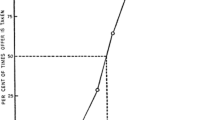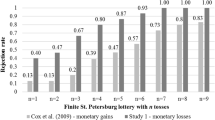Abstract
This paper proposes a new decision theory of how individuals make random errors when they compute the expected utility of risky lotteries. When distorted by errors, the expected utility of a lottery never exceeds (falls below) the utility of the highest (lowest) outcome. This assumption implies that errors are likely to overvalue (undervalue) lotteries with expected utility close to the utility of the lowest (highest) outcome. Proposed theory explains many stylized empirical facts such as the fourfold pattern of risk attitudes, common consequence effect (Allais paradox), common ratio effect and violations of betweenness. Theory fits the data from ten well-known experimental studies at least as well as cumulative prospect theory.





Similar content being viewed by others
Notes
Computational errors occur for a variety of reasons (Hey and Orme 1994). An individual may not be sufficiently motivated to make a balanced decision. A subject can get tired during a long experiment and pay less attention (especially if lotteries do not involve losses). A subject can simply press a wrong key by accident or inertia. Wu (1994, p.50) suggests that subjects can suffer from fatigue and hurry up with their responses at the end of the experiment.
For example, in the Allais paradox, this condition is satisfied when the gain of one million starting from zero wealth position brings a higher increase in utility than the gain of an additional four million.
Bernasconi (1994) finds the common ratio effect when θ = 0.8 and θ = 0.75. Loomes and Sugden (1998) find evidence of the common ratio effect when \( \theta \in {\left\{ {0.6,2 \mathord{\left/ {\vphantom {2 3}} \right. \kern-\nulldelimiterspace} 3,0.8} \right\}} \), and no such evidence when θ = 0.4 and θ = 0.5.
Tversky and Kahneman (1992) also used eight decision problems involving mixed lotteries with positive and negative outcomes. Unfortunately, Richard Gonzalez, who conducted the experiment for Tversky and Kahneman (1992) could not find the raw data on these mixed lotteries and no reexamination was possible.
Non-linear unconstrained optimization was implemented in the Matlab 6.5 package (based on the Nelder–Mead simplex algorithm).
Specifically, the utility of lottery L(x 1, p 1;...x n , p n ) with outcomes \( x_{1} < \ldots < x_{m} < 0 \leqslant x_{{m + 1}} < \ldots < x_{n} \) is \( \widetilde{u}{\left( L \right)} = {\sum\nolimits_{i = 1}^m {u^{ - } {\left( {x_{i} } \right)}{\left( {w^{ - } {\left( {{\sum\nolimits_{j = 1}^i {p_{j} } }} \right)} - w^{ - } {\left( {{\sum\nolimits_{j = 1}^{i - 1} {p_{j} } }} \right)}} \right)}} } + {\sum\nolimits_{i = m + 1}^n {u^{ + } {\left( {x_{i} } \right)}{\left( {w^{ + } {\left( {{\sum\nolimits_{j = i}^n {p_{j} } }} \right)} - w^{ + } {\left( {{\sum\nolimits_{j = i + 1}^n {p_{j} } }} \right)}} \right)}} } \), where \( u^{ - } {\left( x \right)} = - \lambda {\left( { - x} \right)}^{\beta } \), \( u^{ + } {\left( x \right)} = x^{\alpha } \), \( w^{ + } {\left( p \right)} = {p^{\gamma } } \mathord{\left/ {\vphantom {{p^{\gamma } } {{\left( {p^{\gamma } + {\left( {1 - p} \right)}^{\gamma } } \right)}^{{1 \mathord{\left/ {\vphantom {1 \gamma }} \right. \kern-\nulldelimiterspace} \gamma }} }}} \right. \kern-\nulldelimiterspace} {{\left( {p^{\gamma } + {\left( {1 - p} \right)}^{\gamma } } \right)}^{{1 \mathord{\left/ {\vphantom {1 \gamma }} \right. \kern-\nulldelimiterspace} \gamma }} } \) and \( w^{ - } {\left( p \right)} = {p^{\delta } } \mathord{\left/ {\vphantom {{p^{\delta } } {{\left( {p^{\delta } + {\left( {1 - p} \right)}^{\delta } } \right)}^{{1 \mathord{\left/ {\vphantom {1 \delta }} \right. \kern-\nulldelimiterspace} \delta }} }}} \right. \kern-\nulldelimiterspace} {{\left( {p^{\delta } + {\left( {1 - p} \right)}^{\delta } } \right)}^{{1 \mathord{\left/ {\vphantom {1 \delta }} \right. \kern-\nulldelimiterspace} \delta }} } \).
I also estimated CPT with a stochastic choice model \( {\text{prob}}{\left( {S \succ R} \right)} = 1 \mathord{\left/ {\vphantom {1 {{\left( {1 + \exp {\left\{ {\tau \cdot {\left( {\widetilde{u}{\left( R \right)} - \widetilde{u}{\left( S \right)}} \right)}} \right\}}} \right)}}}} \right. \kern-\nulldelimiterspace} {{\left( {1 + \exp {\left\{ {\tau \cdot {\left( {\widetilde{u}{\left( R \right)} - \widetilde{u}{\left( S \right)}} \right)}} \right\}}} \right)}} \), τ = const, proposed by Luce and Suppes (1965, p.335) and used by Camerer and Ho (1994) and Wu and Gonzalez (1996). The result of this estimation was nearly identical to the estimation of CPT with the Fechner model.
Kagel et al. (1990) allowed the subjects to express indifference but do not report how many subjects actually used this possibility. Camerer (1989) allowed indifference in one experimental session. Camerer (1989) reports that three subjects revealed indifference in almost every decision problem, and the rest never expressed indifference.
There is also a practical constraint why the reexamination of individual choice patterns is not feasible. Many of the experimental studies reexamined in this section were conducted over a decade ago and several authors, whom I contacted, could not find raw experimental data.
References
Allais, Maurice. (1953). “Le Comportement de L’homme Rationnel Devant le Risque: Critique des Postulates et Axiomes de L’école Américaine,” Econometrica 21, 503–546.
Ballinger, Parker T., and Nathaniel T. Wilcox. (1997). “Decisions, Error and Heterogeneity,” Economic Journal 107, 1090–1005.
Battalio, Raymond, John H. Kagel, and Romain Jiranyakul. (1990). “Testing Between Alternative Models of Choice Under Uncertainty: Some Initial Results,” Journal of Risk and Uncertainty 3, 25–50.
Becker, Gordon M., Morris H. DeGroot, and Jacob Marschak. (1963). “Stochastic Models of Choice Behavior,” Behavioral Science 8, 41–55.
Bernasconi, Michele. (1994). “Nonlineal Preference and Two-stage Lotteries: Theories and Evidence,” Economic Journal 104, 54–70.
Blavatskyy, Pavlo R. (2005). “A Stochastic Expected Utility Theory,” IEW working paper 231, http://www.iew.unizh.ch/wp/iewwp231.pdf.
Blavatskyy, Pavlo R. (2006a). “Violations of Betweenness or Random Errors?” Economics Letters 91, 34–38.
Blavatskyy, Pavlo R. (2006b). “Stochastic Choice Under Risk,” IEW working paper 272, http://www.iew.unizh.ch/wp/iewwp272.pdf.
Buschena, David, and David Zilberman. (2000). “Generalized Expected Utility, Heteroscedastic Error, and Path Dependence in Risky Choice,” Journal of Risk and Uncertainty 20, 67–88.
Camerer, Colin F. (1989). “An Experimental Test of Several Generalized Utility Theories,” Journal of Risk and Uncertainty 2, 61–104.
Camerer, Colin F. (1992). “Recent Tests of Generalizations of Expected Utility Theory.” In Ward Edwards (ed.), Utility: Theories, Measurement, and Applications. Norwell, MA: Kluwer.
Camerer, Colin F. (1995). “Individual Decision Making.” In John Kagel and Alvin Roth (eds.), The Handbook of Experimental Economics. Princeton: Princeton University Press.
Camerer, Colin F., and Teck-Hua Ho. (1994). “Violations of the Betweenness Axiom and Nonlinearity in Probability,” Journal of Risk and Uncertainty 8, 167–196.
Carbone, Enrica, and John D. Hey. (2000). “Which Error Story is Best?” Journal of Risk and Uncertainty 20, 161–176.
Chew, Soo-Hong, and William S. Waller. (1986). “Empirical Tests of Weighted Utility Theory,” Journal of Mathematical Psychology 30, 55–72.
Conlisk, John. (1989). “Three Variants on the Allais Example,” American Economic Review 79, 392–407.
Coombs, Clyde, and Lily Huang. (1976). “Tests of the Betweenness Property of Expected Utility,” Journal of Mathematical Psychology 13, 323–337.
Dekel, Eddie. (1986). “An Axiomatic Characterization of Preferences Under Uncertainty,” Journal of Economic Theory 40, 304–318.
Friedman, Milton, and Jimmie L. Savage. (1948). “The Utility Analysis of Choices Involving Risk,” Journal of Political Economy 56, 279–304.
Gigliotti, Gary, and Barry Sopher. (1993). “A Test of Generalized Expected Utility Theory,” Theory and Decision 35, 75–106.
Gneezy, Uri, John List, and George Wu. (2006). “The Uncertainty Effect: When a Risky Prospect is Valued Less than its Worst Possible Outcome,” Quarterly Journal of Economics 121, 1283–1309.
Gonzalez, Richard, and George Wu. (1999). “On the Shape of the Probability Weighting Function,” Cognitive Psychology 38, 129–166.
Harless, David, and Colin F. Camerer. (1994). “The Predictive Utility of Generalized Expected Utility Theories,” Econometrica 62, 1251–1289.
Hertwig, Ralph, and Andreas Ortmann. (2001). “Experimental Practices in Economics: A Methodological Challenge for Psychologists?” Behavioral and Brain Sciences 24, 383–451.
Hey, John D. (1995). “Experimental Investigations of Errors in Decision Making Under Risk,” European Economic Review 39, 633–640.
Hey, John D. (2001). “Does Repetition Improve Consistency?” Experimental Economics 4, 5–54.
Hey, John D. (2005). “Why We Should Not be Silent About Noise,” Experimental Economics 8, 325–345.
Hey, John D., and Enrica Carbone. (1995). “Stochastic Choice with Deterministic Preferences: An Experimental Investigation,” Economics Letters 47, 161–167.
Hey, John D., and Chris Orme. (1994). “Investigating Generalisations of Expected Utility Theory Using Experimental Data,” Econometrica 62, 1291–1326.
Kagel, John H., Don N. MacDonald, and Raymond C. Battalio. (1990). “Tests of ‘Fanning Out’ of Indifference Curves: Results from Animal and Human Experiments,” American Economic Review 80, 912–921.
Kahneman, Daniel, and Amos Tversky. (1979). “Prospect Theory: An Analysis of Decision Under Risk,” Econometrica 47, 263–291.
Knight, Frank H. (1921). Risk, Uncertainty, and Profit. New York: Houghton Mifflin.
Loomes, Graham, and Robert Sugden. (1995). “Incorporating a Stochastic Element into Decision Theories,” European Economic Review 39, 641–648.
Loomes, Graham, and Robert Sugden. (1998). “Testing Different Stochastic Specifications of Risky Choice,” Economica 65, 581–598.
Loomes, Graham, Peter Moffatt, and Robert Sugden. (2002). “A Microeconomic Test of Alternative Stochastic Theories of Risky Choice,” Journal of Risk and Uncertainty 24, 103–130.
Luce, R. Duncan, and Patrick Suppes. (1965). “Preference, Utility, and Subjective Probability.” In R. Duncan Luce, Robert R. Bush, and Eugene Galanter (eds.), Handbook of Mathematical Psychology, Vol. III, 249–410. New York: Wiley.
MacCrimmon, Kenneth, and Stig Larsson. (1979). “Utility Theory: Axioms Versus Paradoxes.” In Maurice Allais and Ole Hagen (eds.), Expected Utility Hypotheses and the Allais Paradox. Dordrecht: Reidel.
Machina, Mark. (1982). “‘Expected Utility’ Analysis Without the Independence Axiom,” Econometrica 50, 277–323.
Machina, Mark. (1985). “Stochastic Choice Functions Generated from Deterministic Preferences over Lotteries,” Economic Journal 95, 575–594.
Markowitz, Harry. (1952). “The Utility of Wealth,” Journal of Political Economy 60, 151–158.
Prelec, Drazen. (1990). “A ‘Pseudo-endowment’ Effect, and its Implications for Some Recent Nonexpected Utility Models,” Journal of Risk and Uncertainty 3, 247–259.
Quiggin, John. (1981). “Risk Perception and Risk Aversion Among Australian Farmers,” Australian Journal of Agricultural Economics 25, 160–169.
Slovic, Paul, and Amos Tversky. (1974). “Who Accepts Savage’s Axiom?” Behavioral Science 19, 368–373.
Smith, Vernon L., and James Walker. (1993). “Monetary Rewards and Decision Cost in Experimental Economics,” Economic Inquiry 31, 245–261.
Starmer, Chris, (2000). “Developments in Non-Expected Utility Theory: The Hunt for a Descriptive Theory of Choice Under Risk,” Journal of Economic Literature 38, 332–382.
Starmer, Chris, and Robert Sugden. (1989). “Probability and Juxtaposition Effects: An Experimental Investigation of the Common Ratio Effect,” Journal of Risk and Uncertainty 2, 159–178.
Tversky, Amos, and Daniel Kahneman. (1992). “Advances in Prospect Theory: Cumulative Representation of Uncertainty,” Journal of Risk and Uncertainty 5, 297–323.
Vuong, Quang H. (1989). “Likelihood Ratio Tests for Model Selection and Non-nested Hypotheses,” Econometrica 57, 307–333.
Wu, George. (1994). “An Empirical Test of Ordinal Independence,” Journal of Risk and Uncertainty 9, 39–60.
Wu, George, and Richard Gonzalez. (1996). “Curvature of the Probability Weighting Function,” Management Science 42, 1676–1690.
Acknowledgments
I am grateful to Colin Camerer, Christian Ewerhart, John Hey, Wolfgang Köhler and Andreas Ortmann as well as the participants of the research seminars in IEW (Zurich, March 31, 2005) and CERGE-EI (Prague, April 14, 2005), the 20th Biennial Conference on Subjective Probability, Utility and Decision Making (Stockholm, August 22, 2005) and the 20th Annual Congress of the European Economic Association (Amsterdam, August 25, 2005) for their extensive comments. I also would like to thank the editor W. Kip Viscusi and one anonymous referee for their helpful suggestions. Richard Gonzalez, George Wu, John Hey and Chris Orme generously provided their experimental data.
Author information
Authors and Affiliations
Corresponding author
Rights and permissions
About this article
Cite this article
Blavatskyy, P.R. Stochastic expected utility theory. J Risk Uncertainty 34, 259–286 (2007). https://doi.org/10.1007/s11166-007-9009-6
Published:
Issue Date:
DOI: https://doi.org/10.1007/s11166-007-9009-6




